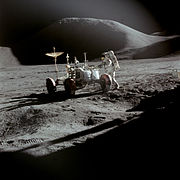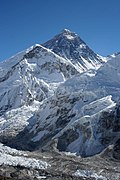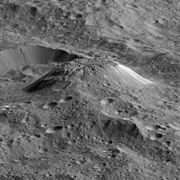太陽系最高山峰列表
以下為太陽系各星球上已知的最高山峰列表,羅列星球上的各類型之最高峰。位於火星上高達22公里的盾狀火山-奧林帕斯山是太陽系所有行星中的最高山峰。在1971年它被發現之後的40年中,奧林帕斯山一直是太陽系中已知的最高峰。然而在2011年發現小行星灶神星的雷亞希爾維亞盆地的中央峰具有與其相仿的高度。

列表[編輯]
由於缺乏精確的平均基準面定義,在此給出的高度為底部到峰頂距離。海平面以上山峰高度僅在地球,可能還有土衛六上可用[1]。在其他星球上,如有足夠可用於計算的數據,則可使用等勢面或參考橢球上方的峰值高程,但情況往往並非如此。
| 星球 | 最高峰 | 山底到山峰高度 | 占半徑比[n 1] | 發源 | 備註 |
|---|---|---|---|---|---|
| 水星 | 卡洛里山脈 | ≤ 3公里(1.9英里)[2][3] | 0.12 | 撞擊[4] | 形成於卡洛里撞擊 |
| 金星 | 斯卡迪山 (麥克斯韋山脈中的山丘) | 6.4公里(4英里)[5] (高於平均線11公里) | 0.11 | 構造[6] | 可能因含硫化鉛的金屬「金星雪」緣故,雷達顯示出明亮的斜坡。[7]。 |
| 馬特山 | 約4.9公里(3英里)[8] | 0.081 | 火山[9] | 金星上最高的火山 | |
| 地球[n 2] | 茂納凱亞火山和茂納洛亞火山 | 10.2公里(6.3英里)[11] | 0.16 | 火山 | 其中高出海平面4.2公里(2.6英里) |
| 哈萊阿卡拉火山 | 9.1公里(5.7英里)[12] | 0.14 | 火山 | 高出海平面3.1公里[12] | |
| 泰德峰 | 7.5公里(4.7英里)[13] | 0.12 | 火山 | 高出海平面3.7公里[13] | |
| 麥金利山 | 5.3-5.9公里(3.3-3.7英里)[14] | 0.093 | 構造 | 陸地上從山腳至山巔最高的山丘[15][n 3] | |
| 珠穆朗瑪峰 | 3.6-4.6公里(2.2-2.9英里)[16] | 0.072 | 構造 | 北坡4.6公里,南坡3.6公里[n 4],海撥最高(8.8公里)(但不是從底部到頂部山脈中最高的)。 | |
| 月球[n 5] | 惠更斯山 | 5.5公里(3.4英里)[19][20] | 0.32 | 撞擊 | 形成於雨海撞擊 |
| 哈德利山 | 4.5公里(2.8英里)[19][20] | 0.26 | 撞擊 | 形成於雨海撞擊 | |
| 呂姆克山 | 1.3公里(0.81英里)[21] | 0.063 | 火山 | 月球上最大的火山構造[21] | |
| 火星 | 奧林帕斯山 | 21.9公里(14英里)[n 6][22][23] | 0.65 | 火山 | 高出1000公里外的北方大平原26公里[24],山頂火山口大小60x80公里,深達3.2公里[23],周圍邊緣陡坡高達8公里[25]。而一般盾狀火山,平均山體坡度只有5.2度[22]。 |
| 阿斯克勞山 | 14.9公里(9.3英里)[22] | 0.44 | 火山 | 三座塔爾西斯山中最高的 | |
| 埃律西昂山 | 12.6公里(7.8英里)[22] | 0.37 | 火山 | 埃律西昂火山區最高的火山 | |
| 阿爾西亞山 | 11.7公里(7.3英里)[22] | 0.35 | 火山 | 山頂破火山口尺寸108至138公里(67至86英里)[22] | |
| 帕弗尼斯山 | 8.4公里(5.2英里)[22] | 0.25 | 火山 | 山頂破火山口深4.8公里(3英里)[22] | |
| 安西瑞斯山 | 6.2公里(3.9英里)[26] | 0.18 | 撞擊 | 形成於希臘撞擊,為火星上非火山類山峰中最高。 | |
| 埃俄利斯山 (「夏普山」) | 4.5-5.5公里(2.8-3.4英里)[27][n 7] | 0.16 | 堆積和侵蝕作用[n 8] | 形成於蓋爾撞擊坑中的沉積物堆積[32],好奇號火星車自2014年11月以來一直往上行駛[33]。 | |
| 灶神星 | 雷亞希爾維亞盆地中央峰 | 220 | 8.4 | 撞擊 | 寬約200公里(120英里),另見:太陽系最大撞擊坑列表 |
| 穀神星 | 阿胡拉山 | 4公里(2.5英里)[35] | 0.85 | 冰火山[36] | 相對平坦區域內孤立的陡峭穹丘,最陡峭一側的最大高度約為5公里,大約位於穀神星上最大撞擊盆地的對跖點上。 |
| 木衛一 | 南博阿索利山脈 [37] | 17.5-18.2公里(10.9-11.3英里)}[38] | 1.0 | 構造 | 東南側有一道15公里(9英里)高的懸崖[39] |
| 愛奧尼亞山東脊 | 約12.7公里(7.9英里)[39][40] | 0.70 | 構造 | 有彎曲的雙脊形狀 | |
| 優卑亞山脈 | 10.3-13.4公里(6.4-8.3英里)[41] | 0.74 | 構造 | 西北側山體滑坡留下2.5萬公里3碎屑坡[42][n 10] | |
| 無名山(西經245度、南緯30度) | 約2.5公里(1.6公里)[43][44] | 0.14 | 火山 | 木衛一眾多火山中最高的一座,呈非典型的圓錐狀[44][n 11] | |
| 土衛一 | 赫歇爾撞擊坑 中央峰 | 約7公里(4英里)[46] | 3.5 | 撞擊 | 另見:太陽系最大撞擊坑列表 |
| 土衛四 | 賈尼科洛皺脊 | 1.5公里(0.9英里)[47] | 0.27 | 構造[n 12] | 周圍地殼凹陷約0.3公里。 |
| 土衛六 | 米斯林山脈 | ≤ 3.3公里(2.1英里)[50] | 0.13 | 構造[50] | 可能是由於全球收縮而形成[51] |
| 末日山 | 1.45公里(0.9英里)[52] | 0.056 | 冰火山[52] | 毗鄰索特拉光斑,有一處1.7公里(1.1英里)深的坍塌特徵[52]。 | |
| 土衛八 | 赤道脊 | 約20公里(12英里)[53] | 2.7 | 不確定[n 13] | 尚未測量過單座山峰 |
| 天衛四 | 未命名 ("側翼山脈") | 約11公里(7英里)[46] | 1.4 | 撞擊 (?) | 「航行者2號」交匯後不久,給出了6公里的高度值[57]。 |
| 冥王星 | 丹增山脈 "T2"峰 | ~6.2公里(3.9)英里[58] | 0.52 | 地殼構造[59] (?) | 由水冰構成[59],取名自丹增諾蓋[60] |
| 皮卡爾山[n 14][61][62] | ~5.5公里(3.4英里)[58] | 0.46 | 冰火山 (?) | 縱橫約220公里[63],中央凹陷深11公里[58]。 | |
| 萊特山[n 14][61][62] | ~4.7公里(2.9英里)[58] | 0.40 | 冰火山 (?) | 縱橫約160公里[61],山頂凹陷直徑~56公里[64],深4.5公里[58]。 | |
| 卡戎 | 巴特勒山[65] | ≥4.5公里(2.8英里)[65] | 0.74 | 地殼構造 (?) | 南部平原—武爾坎平原,有幾座孤立的山峰,可能是傾斜的地殼塊體[65]。 |
| 桃樂斯撞擊坑中央峰[65] | ~4公里(2.5英里)[65] | 0.66 | 撞擊 | 卡戎最大的北極撞擊盆地-桃樂斯撞擊坑,直徑約240公里,深6公里[65]。 |
按高度排序的最高山脈[編輯]
- 奧林帕斯山 72000英尺(22000米)
- 赤道脊 65617英尺(20000米)
- 南博阿索利山 59711英尺(18200米)
- 阿斯克勞山 49000英尺(15000米)
- 愛奧尼亞山 41667英尺(12700米)
- 埃律西昂山 41338英尺(12600米)
- 阿爾西亞山 38386英尺(11700米)
- 側翼山脈 36089英尺(11000米)
- 斯卡迪山 35105英尺(10700米)
- 優卑亞山脈 34449英尺(10500米)
- 茂納凱亞火山 33464英尺(10200米)
- 哈萊阿卡拉火山 29856英尺(9100米)
- 珠穆朗瑪峰 29029英尺(8848米)
- 帕弗尼斯山 28543英尺(8700米)
- 泰德峰 24606英尺(7500米)
- 赫歇爾峰 22966英尺(7000米)
- 安西瑞斯山 20341英尺(6200米)
- 丹增山脈 20341英尺(6200米)
- 麥金利峰 20310英尺(6190米)
- 吉力馬札羅山 19341英尺(5895米)
- 惠更斯山 18045英尺(5500米)
- 埃俄利斯山 18045英尺(5500米)
- 皮卡爾山 18045英尺(500米)
- 馬特山 16076英尺(4900米)
- 萊特山15420英尺(4700米)
- 哈德利山 14764英尺(4500米)
- 巴特勒山 14764英尺(4500米)
- 阿胡拉山 13500英尺(4100米)
- 桃樂斯峰13123英尺(米)
- 米斯林山脈 10948英尺(3337米)
- 卡洛里山脈 9843英尺(3000米)
- 木衛一無名峰 8202英尺(2500米)
- 賈尼科洛皺脊 4921英尺(100米)
- 末日山 4757英尺(1450米)
- 呂姆克山 4265英尺(1300米)
圖集[編輯]
以下圖片根據山底到山峰的高度按降序排列
參見[編輯]
注釋[編輯]
- ^ 山峰高度占所在星球半徑的百分比。
- ^ 地球上的山脈高度受到冰川作用的限制,山峰通常限制在雪線(隨緯度不同而變化)上方不超過 1500 米的高度。但迅速形成的火山往往會打破這種趨勢[10]。
- ^ 赫爾曼(2005)第20頁:「麥金利山從山腳到山頂的高度是所有完全位於海平面之上山脈中最大的,約有18000英尺(5500 米)」。
- ^ 山峰位於海平面以上8.8公里(5.5英里),高出大洋深海平原13公里(8.1英里)。
- ^ 隕石坑壘壁上的凸起部分通常不被視為山峰,此處未列出。一個突出的例子是位於塞曼環形山外側坡上的一處未命名(正式)山丘,它高出相鄰部分坑壁約4公里,與環形山坑底落差約7.57公里[17],該山丘的形成似乎不能簡單地根據撞擊事件來解釋[18]。
- ^ 由於測量精度的限制以及缺乏對「基準」的精確定義,因此,很難說到底是這座山峰,還是灶神星雷亞希爾維亞盆地的中央峰是太陽系中最高的山峰。
- ^ 從「好奇號」著陸點的視角看,高度約為5.25公里[28]。
- ^ 撞擊坑中央的山峰可能位於沉積物堆的下方,如果這些沉積物是在隕坑被淹沒時沉積的,那麼在侵蝕過程起主導作用前,隕坑可能已被完全填滿[27]。然而,如果沉積是由從坑壁上下沉的下降風所引起,則就如報導的土堆層3度徑向坡度所表明的那樣,侵蝕的作用將為土堆的生長設置上限[29][30]。「好奇號」的重力測量表明,隕石坑從未被沉積物掩埋,這與後一種情況一致[31]。
- ^ 由於測量精度的限制和缺乏「基準」的精確定義,很難說這座山峰,還是火星上的奧林帕斯火山為太陽系中的最高峰。
- ^ 太陽系中最大[42]
- ^ 其中一些火山口周圍布滿放射狀熔岩流,表明它們處於地形高處,成為一座盾狀火山。這些火山大多隆起不足1公里,只有少數高度較高,魯瓦火山口中在300公里寬範圍內上升了2.5至3公里,但它的坡度只有1度[45]。木衛一一些較小的盾狀火山具有更陡峭的錐形輪廓,列出的示例為寬60公里,平均坡度為4度,接近小山頂火山口時達到6-7度。[45]。
- ^ 顯然是通過收縮形成[48][49]。
- ^ 起源假說包括與潮汐鎖定引起的扁率下降相關的地殼重新調整[54][55]以及從前環繞該衛星的行星環脫軌道物質的沉積[56]。
- ^ 14.0 14.1 該命名尚未得到國際天文聯合會批准
- ^ 一幅直線化的廣角避險相機圖像,使山丘看上去比實際更陡峭,峰頂在此圖中看不到。
參考資料[編輯]
- ^ Hayes, A.G.; Birch, S.P.D.; Dietrich, W.E.; Howard, A.D.; Kirk, R.L.; Poggiali, V.; Mastrogiuseppe, M.; Michaelides, R.J.; Corlies, P.M.; Moore, J.M.; Malaska, M.J.; Mitchell, K.L.; Lorenz, R.D.; Wood, C.A. Topographic Constraints on the Evolution and Connectivity of Titan's Lacustrine Basins. Geophysical Research Letters. 2017, 44 (23): 11,745–11,753. doi:10.1002/2017GL075468
 .
.
- ^ Surface. MESSENGER web site. Johns Hopkins University/Applied Physics Lab. [4 April 2012]. (原始內容存檔於30 September 2016).
- ^ Oberst, J.; Preusker, F.; Phillips, R. .; Watters, T. R.; Head, J. W.; Zuber, M. T.; Solomon, S. C. The morphology of Mercury's Caloris basin as seen in MESSENGER stereo topographic models. Icarus. 2010, 209 (1): 230–238. Bibcode:2010Icar..209..230O. ISSN 0019-1035. doi:10.1016/j.icarus.2010.03.009.
- ^ Fassett, C. I.; Head, J. W.; Blewett, D. T.; Chapman, C. R.; Dickson, J. L.; Murchie, S. L.; Solomon, S. C.; Watters, T. R. Caloris impact basin: Exterior geomorphology, stratigraphy, morphometry, radial sculpture, and smooth plains deposits. Earth and Planetary Science Letters. 2009, 285 (3–4): 297–308. Bibcode:2009E&PSL.285..297F. ISSN 0012-821X. doi:10.1016/j.epsl.2009.05.022.
- ^ Jones, Tom; Stofan, Ellen. Planetology : Unlocking the secrets of the solar system. Washington, D.C.: National Geographic Society. 2008: 74 [2021-11-21]. ISBN 978-1-4262-0121-9. (原始內容存檔於2017-07-16).
- ^ Keep, M.; Hansen, V. L. Structural history of Maxwell Montes, Venus: Implications for Venusian mountain belt formation. Journal of Geophysical Research. 1994, 99 (E12): 26015. Bibcode:1994JGR....9926015K. ISSN 0148-0227. doi:10.1029/94JE02636.
- ^ Otten, Carolyn Jones. 'Heavy metal' snow on Venus is lead sulfide. Newsroom (Washington University in Saint Louis). 10 February 2004 [10 December 2012]. (原始內容存檔於2016-01-29).
- ^ PIA00106: Venus - 3D Perspective View of Maat Mons. Planetary Photojournal. Jet Propulsion Lab. 1996-08-01 [30 June 2012]. (原始內容存檔於2019-08-10).
- ^ Robinson, C. A.; Thornhill, G. D.; Parfitt, E. A. Large-scale volcanic activity at Maat Mons: Can this explain fluctuations in atmospheric chemistry observed by Pioneer Venus?. Journal of Geophysical Research. January 1995, 100 (E6): 11755–11764 [11 February 2013]. Bibcode:1995JGR...10011755R. doi:10.1029/95JE00147. (原始內容存檔於2012-03-01).
- ^ Egholm, D. L.; Nielsen, S. B.; Pedersen, V. K.; Lesemann, J.-E. Glacial effects limiting mountain height. Nature. 2009, 460 (7257): 884–887. Bibcode:2009Natur.460..884E. PMID 19675651. S2CID 205217746. doi:10.1038/nature08263.
- ^ Mountains: Highest Points on Earth. National Geographic Society. [19 September 2010]. (原始內容存檔於2016-03-04).
- ^ 12.0 12.1 Haleakala National Park Geology Fieldnotes. U.S. National Park Service. [31 January 2017]. (原始內容存檔於2017-02-02).
- ^ 13.0 13.1 Teide National Park. UNESCO World Heritage Site list. UNESCO. [2 June 2013]. (原始內容存檔於2022-06-12).
- ^ NOVA Online: Surviving Denali, The Mission. NOVA web site. Public Broadcasting Corporation. 2000 [7 June 2007]. (原始內容存檔於2010-11-20).
- ^ Adam Helman. The Finest Peaks: Prominence and Other Mountain Measures. Trafford Publishing. 2005 [9 December 2012]. ISBN 978-1-4120-5995-4. (原始內容存檔於2020-10-31).
- ^ Mount Everest (1:50,000 scale map), prepared under the direction of Bradford Washburn for the Boston Museum of Science, the Swiss Foundation for Alpine Research, and the National Geographic Society, 1991, ISBN 3-85515-105-9
- ^ Robinson, M. Mountains of the Moon: Zeeman Mons. LROC.sese.asu. Arizona State University. 20 November 2017 [5 September 2020]. (原始內容存檔於2021-11-12).
- ^ Ruefer, A.C.; James, P.B. Zeeman Crater's Anomalous Massif (PDF). 51st Lunar and Planetary Science Conference: 2673. March 2020 [2021-11-21]. Bibcode:2020LPI....51.2673R. (原始內容 (PDF)存檔於2021-09-09).
- ^ 19.0 19.1 Fred W. Price. The Moon observer's handbook. London: Cambridge University Press. 1988. ISBN 978-0-521-33500-3.
- ^ 20.0 20.1 Moore, Patrick. On the Moon
 . London: Cassell & Co. 2001. ISBN 9780304354696.
. London: Cassell & Co. 2001. ISBN 9780304354696.
- ^ 21.0 21.1 Wöhler, C.; Lena, R.; Pau, K. C. The Lunar Dome Complex Mons Rümker:Morphometry, Rheology, and Mode of Emplacement. 38th Lunar and Planetary Science Conference (1338): 1091. 16 March 2007. Bibcode:2007LPI....38.1091W.
- ^ 22.0 22.1 22.2 22.3 22.4 22.5 22.6 22.7 Plescia, J. B. Morphometric properties of Martian volcanoes. Journal of Geophysical Research. 2004, 109 (E3): E03003. Bibcode:2004JGRE..109.3003P. ISSN 0148-0227. doi:10.1029/2002JE002031.
- ^ 23.0 23.1 Carr, Michael H. The Surface of Mars. Cambridge University Press. 11 January 2007: 51 [2021-11-21]. ISBN 978-1-139-46124-5. (原始內容存檔於2021-06-24).
- ^ Comins, Neil F. Discovering the Essential Universe. Macmillan. 4 January 2012 [23 December 2012]. ISBN 978-1-4292-5519-6. (原始內容存檔於2021-11-09).
- ^ Lopes, R.; Guest, J. E.; Hiller, K.; Neukum, G. Further evidence for a mass movement origin of the Olympus Mons aureole. Journal of Geophysical Research. January 1982, 87 (B12): 9917–9928. Bibcode:1982JGR....87.9917L. doi:10.1029/JB087iB12p09917.
- ^ JMARS MOLA elevation dataset. Christensen, P.; Gorelick, N.; Anwar, S.; Dickenshied, S.; Edwards, C.; Engle, E. (2007) "New Insights About Mars From the Creation and Analysis of Mars Global Datasets (頁面存檔備份,存於網際網路檔案館);" American Geophysical Union, Fall Meeting, abstract #P11E-01.
- ^ 27.0 27.1 Gale Crater's History Book. Mars Odyssey THEMIS web site. Arizona State University. [7 December 2012]. (原始內容存檔於2008-11-04).
- ^ Anderson, R. B.; Bell III, J. F. Geologic mapping and characterization of Gale Crater and implications for its potential as a Mars Science Laboratory landing site. International Journal of Mars Science and Exploration. 2010, 5: 76–128. Bibcode:2010IJMSE...5...76A. doi:10.1555/mars.2010.0004.
- ^ Wall, M. Bizarre Mars Mountain Possibly Built by Wind, Not Water. Space.com. 6 May 2013 [13 May 2013]. (原始內容存檔於2019-04-28).
- ^ Kite, E. .; Lewis, K. W.; Lamb, M. .; Newman, C. E.; Richardson, M. . Growth and form of the mound in Gale Crater, Mars: Slope wind enhanced erosion and transport. Geology. 2013, 41 (5): 543–546. Bibcode:2013Geo....41..543K. ISSN 0091-7613. S2CID 119249853. arXiv:1205.6840
 . doi:10.1130/G33909.1.
. doi:10.1130/G33909.1.
- ^ Lewis, K. W.; Peters, S.; Gonter, K.; Morrison, S.; Schmerr, N.; Vasavada, A. R.; Gabriel, T. A surface gravity traverse on Mars indicates low bedrock density at Gale crater. Science. 2019, 363 (6426): 535–537. Bibcode:2019Sci...363..535L. PMID 30705193. S2CID 59567599. doi:10.1126/science.aat0738
 .
.
- ^ Agle, D. C. 'Mount Sharp' On Mars Links Geology's Past and Future. NASA. 28 March 2012 [31 March 2012]. (原始內容存檔於2012-03-31).
- ^ Webster, Gay; Brown, Dwayne. Curiosity Arrives at Mount Sharp. NASA Jet Propulsion Laboratory. 9 November 2014 [16 October 2016]. (原始內容存檔於2 December 2014).
- ^ Vega, P. New View of Vesta Mountain From NASA's Dawn Mission. Jet Propulsion Lab's Dawn mission web site. NASA. 11 October 2011 [29 March 2012]. (原始內容存檔於22 October 2011).
- ^ Dawn's First Year at Ceres: A Mountain Emerges. JPL Dawn website. Jet Propulsion Lab. 2016-03-07 [2016-03-08]. (原始內容存檔於2017-02-18).
- ^ Ruesch, O.; Platz, T.; Schenk, P.; McFadden, L. A.; Castillo-Rogez, J. C.; Quick, L. C.; Byrne, S.; Preusker, F.; OBrien, D. P.; Schmedemann, N.; Williams, D. A.; Li, J.- Y.; Bland, M. T.; Hiesinger, H.; Kneissl, T.; Neesemann, A.; Schaefer, M.; Pasckert, J. H.; Schmidt, B. E.; Buczkowski, D. L.; Sykes, M. V.; Nathues, A.; Roatsch, T.; Hoffmann, M.; Raymond, C. A.; Russell, C. T. Cryovolcanism on Ceres. Science. 2016-09-02, 353 (6303): aaf4286. Bibcode:2016Sci...353.4286R. PMID 27701087. doi:10.1126/science.aaf4286
 .
.
- ^ Perry, Jason. Boösaule Montes. Gish Bar Times blog. 27 January 2009 [30 June 2012]. (原始內容存檔於2019-07-30).
- ^ Schenk, P.; Hargitai, H. Boösaule Montes. Io Mountain Database. [30 June 2012]. (原始內容存檔於2019-07-25).
- ^ 39.0 39.1 Schenk, P.; Hargitai, H.; Wilson, R.; McEwen, A.; Thomas, P. The mountains of Io: Global and geological perspectives from Voyager and Galileo. Journal of Geophysical Research. 2001, 106 (E12): 33201. Bibcode:2001JGR...10633201S. ISSN 0148-0227. doi:10.1029/2000JE001408
 .
.
- ^ Schenk, P.; Hargitai, H. Ionian Mons. Io Mountain Database. [30 June 2012]. (原始內容存檔於2019-07-29).
- ^ Schenk, P.; Hargitai, H. Euboea Montes. Io Mountain Database. [30 June 2012]. (原始內容存檔於2018-10-03).
- ^ 42.0 42.1 Martel, L. M. V. Big Mountain, Big Landslide on Jupiter's Moon, Io. NASA Solar System Exploration web site. 16 February 2011 [30 June 2012]. (原始內容存檔於13 January 2011).
- ^ Moore, J. M.; McEwen, A. S.; Albin, E. .; Greeley, R. Topographic evidence for shield volcanism on Io. Icarus. 1986, 67 (1): 181–183. Bibcode:1986Icar...67..181M. ISSN 0019-1035. doi:10.1016/0019-1035(86)90183-1.
- ^ 44.0 44.1 Schenk, P.; Hargitai, H. Unnamed volcanic mountain. Io Mountain Database. [6 December 2012]. (原始內容存檔於2019-07-31).
- ^ 45.0 45.1 Schenk, P. M.; Wilson, R. R.; Davies, R. G. Shield volcano topography and the rheology of lava flows on Io. Icarus. 2004, 169 (1): 98–110. Bibcode:2004Icar..169...98S. doi:10.1016/j.icarus.2004.01.015.
- ^ 46.0 46.1 Moore, Jeffrey M.; Schenk, Paul M.; Bruesch, Lindsey S.; Asphaug, Erik; McKinnon, William B. Large impact features on middle-sized icy satellites (PDF). Icarus. October 2004, 171 (2): 421–443 [2021-11-21]. Bibcode:2004Icar..171..421M. doi:10.1016/j.icarus.2004.05.009. (原始內容 (PDF)存檔於2018-10-02).
- ^ Hammond, N. P.; Phillips, C. B.; Nimmo, F.; Kattenhorn, S. A. Flexure on Dione: Investigating subsurface structure and thermal history. Icarus. March 2013, 223 (1): 418–422. Bibcode:2013Icar..223..418H. doi:10.1016/j.icarus.2012.12.021.
- ^ Beddingfield, C. B.; Emery, J. P.; Burr, D. M. Testing for a Contractional Origin of Janiculum Dorsa on the Northern, Leading Hemisphere of Saturn's Moon Dione. 44th Lunar and Planetary Science Conference, LPI Contribution No. 1719. Lunar and Planetary Science Conference (1719): 1301. March 2013. Bibcode:2013LPI....44.1301B.
- ^ Overlooked Ocean Worlds Fill the Outer Solar System (頁面存檔備份,存於網際網路檔案館).John Wenz, Scientific American. 4 October 2017.
- ^ 50.0 50.1 PIA20023: Radar View of Titan's Tallest Mountains. Photojournal.jpl.nasa.gov. Jet Propulsion Laboratory. 2016-03-24 [2016-03-25]. (原始內容存檔於2017-08-25).
- ^ Mitri, G.; Bland, M. T.; Showman, A. P.; Radebaugh, J.; Stiles, B.; Lopes, R. M. C.; Lunine, Jonathan I.; Pappalardo, R. T. Mountains on Titan: Modeling and observations. Journal of Geophysical Research. 2010, 115 (E10002): E10002 [5 July 2012]. Bibcode:2010JGRE..11510002M. doi:10.1029/2010JE003592
 . (原始內容存檔於2020-01-26).
. (原始內容存檔於2020-01-26).
- ^ 52.0 52.1 52.2 Lopes, R. M. C.; Kirk, R. L.; Mitchell, K. L.; LeGall, A.; Barnes, J. W.; Hayes, A.; Kargel, J.; Wye, L.; Radebaugh, J.; Stofan, E. R.; Janssen, M. A.; Neish, C. D.; Wall, S. D.; Wood, C. A.; Lunine, Jonathan I.; Malaska, M. J. Cryovolcanism on Titan: New results from Cassini RADAR and VIMS (PDF). Journal of Geophysical Research: Planets. 19 March 2013, 118 (3): 416 [2021-11-21]. Bibcode:2013JGRE..118..416L. doi:10.1002/jgre.20062
 . (原始內容 (PDF)存檔於2019-09-01).
. (原始內容 (PDF)存檔於2019-09-01).
- ^ Giese, B.; Denk, T.; Neukum, G.; Roatsch, T.; Helfenstein, P.; Thomas, P. C.; Turtle, E. P.; McEwen, A.; Porco, C. C. The topography of Iapetus' leading side. Icarus. 2008, 193 (2): 359–371 [2013-04-13]. Bibcode:2008Icar..193..359G. ISSN 0019-1035. doi:10.1016/j.icarus.2007.06.005. (原始內容 (PDF)存檔於2020-03-13).
- ^ Porco, C. C.; et al. Cassini Imaging Science: Initial Results on Phoebe and Iapetus (PDF). Science. 2005, 307 (5713): 1237–1242 [2021-11-21]. Bibcode:2005Sci...307.1237P. ISSN 0036-8075. PMID 15731440. S2CID 20749556. doi:10.1126/science.1107981. 2005Sci...307.1237P. (原始內容 (PDF)存檔於2018-07-19).
- ^ Kerr, Richard A. How Saturn's Icy Moons Get a (Geologic) Life. Science. 2006-01-06, 311 (5757): 29 [2013-04-13]. PMID 16400121. S2CID 28074320. doi:10.1126/science.311.5757.29. (原始內容存檔於2008-08-07).
- ^ Ip, W.-H. On a ring origin of the equatorial ridge of Iapetus (PDF). Geophysical Research Letters. 2006, 33 (16): L16203 [2013-04-13]. Bibcode:2006GeoRL..3316203I. ISSN 0094-8276. doi:10.1029/2005GL025386
 . (原始內容 (PDF)存檔於2019-06-26).
. (原始內容 (PDF)存檔於2019-06-26).
- ^ Moore, P.; Henbest, N. Uranus - the View from Voyager. Journal of the British Astronomical Association. April 1986, 96 (3): 131–137. Bibcode:1986JBAA...96..131M.
- ^ 58.0 58.1 58.2 58.3 58.4 Schenk, P. M.; Beyer, R. A.; McKinnon, W. B.; Moore, J. M.; Spencer, J. R.; White, O. L.; Singer, K.; Nimmo, F.; Thomason, C.; Lauer, T. R.; Robbins, S.; Umurhan, O. M.; Grundy, W. M.; Stern, S. A.; Weaver, H. A.; Young, L. A.; Smith, K. E.; Olkin, C. Basins, fractures and volcanoes: Global cartography and topography of Pluto from New Horizons. Icarus. 2018, 314: 400–433. Bibcode:2018Icar..314..400S. doi:10.1016/j.icarus.2018.06.008.
- ^ 59.0 59.1 Hand, E.; Kerr, R. Pluto is alive—but where is the heat coming from?. Science. 15 July 2015. doi:10.1126/science.aac8860.
- ^ Pokhrel, Rajan. Nepal's mountaineering fraternity happy over Pluto mountains named after Tenzing Norgay Sherpa - Nepal's First Landmark In The Solar System. The Himalayan Times. 19 July 2015 [19 July 2015]. (原始內容存檔於2015-08-13).
- ^ 61.0 61.1 61.2 At Pluto, New Horizons Finds Geology of All Ages, Possible Ice Volcanoes, Insight into Planetary Origins. New Horizons News Center. The Johns Hopkins University Applied Physics Laboratory LLC. 2015-11-09 [2015-11-09]. (原始內容存檔於2019-09-03).
- ^ 62.0 62.1 Witze, A. Icy volcanoes may dot Pluto's surface. Nature. 2015-11-09 [2015-11-09]. S2CID 182698872. doi:10.1038/nature.2015.18756. (原始內容存檔於2015-11-10).
- ^ Ice Volcanoes and Topography. New Horizons Multimedia. The Johns Hopkins University Applied Physics Laboratory LLC. 2015-11-09 [2015-11-09]. (原始內容存檔於13 November 2015).
- ^ Ice Volcanoes on Pluto?. New Horizons Multimedia. The Johns Hopkins University Applied Physics Laboratory LLC. 2015-11-09 [2015-11-09]. (原始內容存檔於11 September 2017).
- ^ 65.0 65.1 65.2 65.3 65.4 65.5 Schenk, P. M.; Beyer, R. A.; McKinnon, W. B.; Moore, J. M.; Spencer, J. R.; White, O. L.; Singer, K.; Umurhan, O. M.; Nimmo, F.; Lauer, T. R.; Grundy, W. M.; Robbins, S.; Stern, S. A.; Weaver, H. A.; Young, L. A.; Smith, K. E.; Olkin, C. Breaking up is hard to do: Global cartography and topography of Pluto's mid-sized icy Moon Charon from New Horizons. Icarus. 2018, 315: 124–145. doi:10.1016/j.icarus.2018.06.010.
外部連結[編輯]
- High resolution side view color image of Rheasilvia's central peak(頁面存檔備份,存於網際網路檔案館) at Planetary.org(頁面存檔備份,存於網際網路檔案館) (peak is at upper right)
- Color mosaic of Vesta's southern hemisphere(頁面存檔備份,存於網際網路檔案館), showing Rheasilvia
- Color panorama of Aeolis Mons(頁面存檔備份,存於網際網路檔案館) from 2012-09-21
- Gigapixel panorama of the Mt. Everest area by David Breashears











![火星埃俄利斯山(「夏普山」)(2012年8月6日「好奇號」火星車拍攝)[n 15]](http://upload.wikimedia.org/wikipedia/commons/thumb/6/65/673885main_PIA15986-full_full.jpg/180px-673885main_PIA15986-full_full.jpg)







